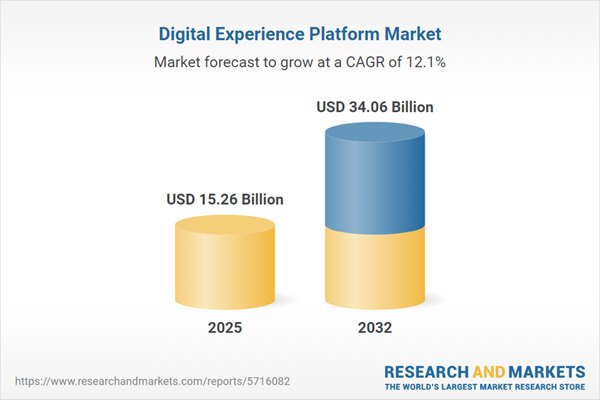Speak directly to the analyst to clarify any post sales queries you may have.
The Digital Experience Platform (DXP) market is undergoing rapid transformation as organizations worldwide seek to integrate emerging technologies, optimize customer touchpoints, and strengthen data-driven strategies. Senior decision-makers are prioritizing platforms that support omnichannel engagement, regulatory compliance, and sustainable growth within a dynamic digital economy.
Market Snapshot: Digital Experience Platform Market Outlook
The Digital Experience Platform market is advancing steadily, experiencing strong year-on-year growth and demonstrating sustained momentum toward higher value solutions. Powered by a CAGR of 12.12%, this sector is expected to more than double in value within the coming years. Key market factors include the adoption of headless architectures, AI-driven personalization, flexible cloud and hybrid models, and increasing focus on security and compliance. This expansion reflects enterprises’ demand for agile, interoperable, and scalable digital solutions that keep pace with evolving user expectations and global business requirements.
Scope & Segmentation
This research report offers a comprehensive analysis of the Digital Experience Platform ecosystem. Segment coverage includes:
- Component: Analytics, Campaign Management, Commerce, Content Management, Digital Asset Management, Personalization
- Analytics Types: Mobile Analytics, Social Analytics, Web Analytics
- Commerce Platforms: B2B Commerce, B2C Commerce
- Content Management Approaches: Headless, Traditional
- Digital Asset Management Solutions: Enterprise DAM, Mid-Market DAM
- Personalization Engines: Predictive, Rule Based
- Deployment Models: Cloud, Hybrid, On-Premise
- Organization Sizes: Large Enterprises, Small and Medium Enterprises
- Industry Verticals: Banking Financial Services and Insurance, Government and Public Sector, Healthcare, Manufacturing, Media and Entertainment, Retail, Telecom
- Regions: Americas (North America, United States, Canada, Mexico, Latin America, Brazil, Argentina, Chile, Colombia, Peru), Europe, Middle East & Africa (Europe, United Kingdom, Germany, France, Russia, Italy, Spain, Netherlands, Sweden, Poland, Switzerland, Middle East, United Arab Emirates, Saudi Arabia, Qatar, Turkey, Israel, Africa, South Africa, Nigeria, Egypt, Kenya), Asia-Pacific (China, India, Japan, Australia, South Korea, Indonesia, Thailand, Malaysia, Singapore, Taiwan)
- Key Companies Analyzed: Adobe Inc., salesforce.com, inc., Oracle Corporation, Sitecore Corporation A/S, Optimizely, Inc., Acquia Inc., SAP SE, Liferay, Inc., OpenText Corporation, Bloomreach, Inc.
Key Takeaways for Senior Decision-Makers
- Cloud-native and hybrid architectures now dominate enterprise strategies, enabling flexible scaling and enhanced resilience across global operations.
- AI and machine learning integration drives advanced personalization and campaign optimization, making real-time analytics and content delivery essential for competitive differentiation.
- Headless and microservices-based approaches provide the agility required for rapid innovation, supporting omnichannel deployment from mobile to emerging IoT and metaverse environments.
- Regulatory compliance, particularly around data privacy and sovereignty, is shaping platform design, with vendors embedding robust governance and encryption capabilities.
- Low-code and no-code tooling is reducing IT dependency, empowering business teams to iterate digital experiences efficiently and align closely with shifting market demands.
- Vendor strategies such as geographic supply chain realignment and service-led partnerships are mitigating volatility and helping organizations manage operational risks globally.
Tariff Impact & Economic Shifts
- Recent US tariff policies on imported hardware have catalyzed shifts in supply chain and manufacturing footprints, prompting nearshoring and regionalized procurement.
- Higher hardware costs for on-premise deployments are accelerating adoption of cloud-based and hybrid DXPs, balancing capital and operational expenditures.
- Market consolidation is intensifying as smaller vendors pursue mergers to navigate tariff-induced cost pressures and scale new deployment models efficiently.
- Enterprises increasingly prioritize service flexibility and platform agility over hardware investments, leveraging multitenant cloud and edge solutions to offset tariff effects.
Methodology & Data Sources
This analysis builds on secondary research from industry reports, regulatory filings, vendor documents, and financial statements, validated through primary consultations with executives and experts. Structured interviews, data triangulation, and rigorous analytical frameworks ensure robust quantitative and qualitative market insights. Peer review processes further validate findings.
Why This Report Matters
- Offers direct decision support for selecting, investing in, and implementing digital experience solutions aligned with technological and regulatory trends.
- Helps organizations benchmark best practices in AI, cloud strategies, and data governance for building competitive, future-ready platforms.
- Informs leaders on regional market nuances and evolving industry vertical requirements, enabling optimized go-to-market plans.
Conclusion
Organizations leveraging modular, scalable digital experience platforms will remain adaptable to change and poised for sustainable growth. Effective alignment with emerging technologies and regional dynamics is essential for continued industry leadership and operational resilience.
Additional Product Information:
- Purchase of this report includes 1 year online access with quarterly updates.
- This report can be updated on request. Please contact our Customer Experience team using the Ask a Question widget on our website.
Table of Contents
3. Executive Summary
4. Market Overview
7. Cumulative Impact of Artificial Intelligence 2025
Companies Mentioned
The companies profiled in this Digital Experience Platform market report include:- Adobe Inc.
- salesforce.com, inc.
- Oracle Corporation
- Sitecore Corporation A/S
- Optimizely, Inc.
- Acquia Inc.
- SAP SE
- Liferay, Inc.
- OpenText Corporation
- Bloomreach, Inc.
Table Information
| Report Attribute | Details |
|---|---|
| No. of Pages | 194 |
| Published | November 2025 |
| Forecast Period | 2025 - 2032 |
| Estimated Market Value ( USD | $ 15.26 Billion |
| Forecasted Market Value ( USD | $ 34.06 Billion |
| Compound Annual Growth Rate | 12.1% |
| Regions Covered | Global |
| No. of Companies Mentioned | 11 |









